Related Research Articles
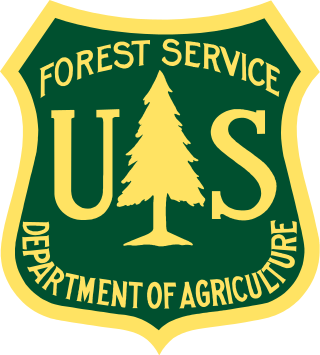
The United States Forest Service (USFS) is an agency of the U.S. Department of Agriculture that administers the nation's 154 national forests and 20 national grasslands. The Forest Service manages 193 million acres (780,000 km2) of land. Major divisions of the agency include the Chief's Office, National Forest System, State and Private Forestry, Business Operations, and Research and Development. The agency manages about 25% of federal lands and is the only major national land management agency not part of the U.S. Department of the Interior.

A firefighter is a first responder trained in firefighting, primarily to control and extinguish fires that threaten life and property, as well as to rescue persons from confinement or dangerous situations. Male firefighters are sometimes referred to as firemen.
This glossary of wildfire terms is a list of definitions of terms and concepts relevant to wildfires and wildland firefighting. Except where noted, terms have largely been sourced from a 1998 Fireline Handbook transcribed for a Conflict 21 counter-terrorism studies website by the Air National Guard.

A fire retardant is a substance that is used to slow down or stop the spread of fire or reduce its intensity. This is commonly accomplished by chemical reactions that reduce the flammability of fuels or delay their combustion. Fire retardants may also cool the fuel through physical action or endothermic chemical reactions. Fire retardants are available as powder, to be mixed with water, as fire-fighting foams and fire-retardant gels. Fire retardants are also available as coatings or sprays to be applied to an object.
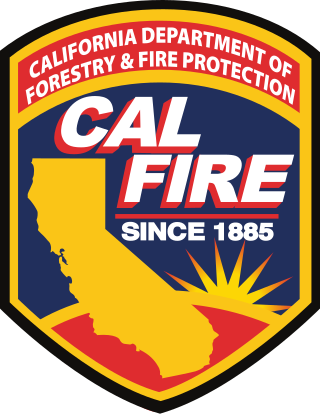
The California Department of Forestry and Fire Protection is the fire department of the California Natural Resources Agency in the U.S. state of California. It is responsible for fire protection in various areas under state responsibility totaling 31 million acres, as well as the administration of the state's private and public forests. In addition, the department provides varied emergency services in 36 of the state's 58 counties via contracts with local governments. The department's current director is Joe Tyler, who was appointed March 4, 2022, by Governor of California Gavin Newsom.

In the United States, a Shot Crew, officially known as an Interagency Hotshot Crew (IHC), is a team of 20-22 elite wildland firefighters that mainly respond to large, high-priority fires across the country and abroad. They are assigned to work the most challenging parts of the fire and are considered strategic and tactical wildland fire experts. Hotshots are a National Resource and their deployment is controlled at the National Level. Hotshot crews are considered the most highly trained, skilled and experienced wildland firefighters, along with Smokejumpers. They are qualified to provide leadership for initial-attack and extended-attack on wildland fires. Hotshots are trained and equipped to work in remote areas for extended periods of time with minimal logistical support. They are organized by agencies such as the United States Forest Service, National Park Service, Bureau of Indian Affairs, Bureau of Land Management, and state/county agencies; the National Interagency Fire Center coordinates hotshot crews on the federal level.
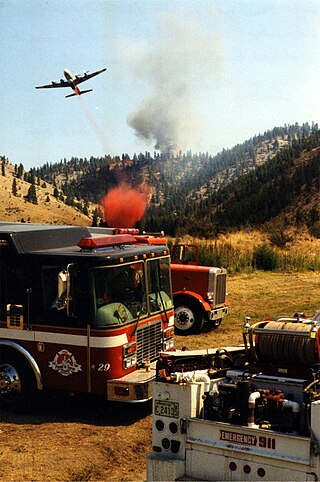
Wildfire suppression is a range of firefighting tactics used to suppress wildfires. Firefighting efforts in wild land areas require different techniques, equipment, and training from the more familiar structure fire fighting found in populated areas. Working in conjunction with specially designed aerial firefighting aircraft, these wildfire-trained crews suppress flames, construct fire lines, and extinguish flames and areas of heat to protect resources and natural wilderness. Wildfire suppression also addresses the issues of the wildland–urban interface, where populated areas border with wild land areas.
In wildland fire suppression in the United States, S-130/S-190 refers to the basic wildland fire training course required of all firefighters before they can work on the firelines.

The New Jersey Department of Environmental Protection (NJDEP) is a government agency in the U.S. state of New Jersey that is responsible for managing the state's natural resources and addressing issues related to pollution. NJDEP now has a staff of approximately 2,850.
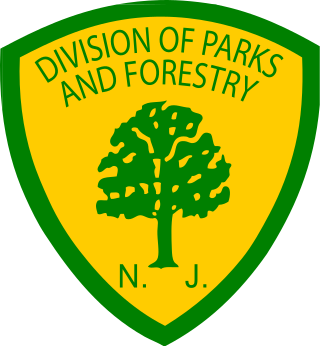
In the state of New Jersey, the New Jersey Division of Parks and Forestry is an administrative division of the New Jersey Department of Environmental Protection. In its most visible role, the Division is directly responsible for the management and operation of New Jersey's public park system which includes 42 state parks, 11 state forests, 3 recreation areas, and more than 50 historic sites and districts. However, its duties also include protecting state and private lands from wildfire, managing forests, educating the public about environmental stewardship and natural resources, as well as growing trees to maintain and restore forests in rural and urban areas, and to preserve the diversity of the trees within the forests.

The Yellowstone fires of 1988 collectively formed the largest wildfire in the recorded history of Yellowstone National Park in the United States. Starting as many smaller individual fires, the flames quickly spread out of control due to drought conditions and increasing winds, combining into several large conflagrations which burned for several months. The fires almost destroyed two major visitor destinations and, on September 8, 1988, the entire park was closed to all non-emergency personnel for the first time in its history. Only the arrival of cool and moist weather in the late autumn brought the fires to an end. A total of 793,880 acres (3,213 km2), or 36 percent of the park, burned at varying levels of severity.

Helitack crews are teams of wildland firefighters who are transported by helicopter to wildfires. Helicopters provide rapid transport, enabling helitack crews to quickly respond and assess a wildfire situation. Helitack crews may land near a wildfire or, if equipped and trained, rappel from a hovering helicopter. Once on the ground, crews build firelines using hand tools, chainsaws, and other firefighting tools. They often remain overnight in remote locations. After they have completed their assignment, crew members may pack up to 120 pounds of equipment over difficult terrain to reach a pick-up point. Rappellers often prepare helispots that provide better access to a fire. Helicopter crew members may also perform other duties such as tree falling, firing operations, and managing helibases.
Wildfire suppression in the United States has had a long and varied history. For most of the 20th century, any form of wildland fire, whether it was naturally caused or otherwise, was quickly suppressed for fear of uncontrollable and destructive conflagrations such as the Peshtigo Fire in 1871 and the Great Fire of 1910. In the 1960s, policies governing wildfire suppression changed due to ecological studies that recognized fire as a natural process necessary for new growth. Today, policies advocating complete fire suppression have been exchanged for those who encourage wildland fire use, or the allowing of fire to act as a tool, such as the case with controlled burns.
Wildfire suppression equipment and personnel is part of the science of fire fighting focusing on the use of specialized equipment, training and tactics to effectively control, surround and eventually extinguish a natural cover fire. There are several specially designed tools that through their function and user training, perform specialized tasks that are specific to natural cover firefighting. This is used together in conjunction with the general understanding of the behavior of fire to form a viable plan of attack.
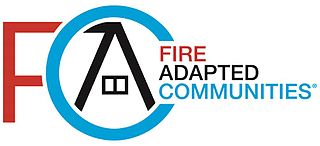
A fire-adapted community is defined by the United States Forest Service as "a knowledgeable and engaged community in which the awareness and actions of residents regarding infrastructure, buildings, landscaping, and the surrounding ecosystem lessens the need for extensive protection actions and enables the community to safely accept fire as a part of the surrounding landscape."

The Nebraska Forest Service is the state forestry agency for the state of Nebraska. The Nebraska Forest Service serves the citizens on Nebraska by operating with the mission to provide services and education to the people of Nebraska for the protection, utilization and enhancement of the State's tree, forest and other natural resources. Headquartered in Lincoln, Nebraska, the Nebraska Forest Service is embedded within the Institution of Agriculture and Natural Resources at the University of Nebraska-Lincoln.

Wildfires are outdoor fires that occur in the wilderness or other vast spaces. Other common names associated with wildfires are brushfire and forest fire. Since wildfires can occur anywhere on the planet, except for Antarctica, they pose a threat to civilizations and wildlife alike. In terms of emergency management, wildfires can be particularly devastating. Given their ability to destroy large areas of entire ecosystems, there must be a contingency plan in effect to be as prepared as possible in case of a wildfire and to be adequately prepared to handle the aftermath of one as well.

The New Jersey Forest Fire Service (NJFFS) is an agency within the New Jersey Department of Environmental Protection. Founded in 1906 with a focus on wildland fire suppression and fire protection, the Forest Fire Service is the largest firefighting department within the state of New Jersey in the United States with 85 full-time professional firefighting personnel, and approximately 2,000 trained part-time on-call wildland firefighters throughout the state. Its mission is to protect "life and property, as well as the state's natural resources, from wildfire".

Wildfires can happen in many places in the United States, especially during droughts, but are most common in the Western United States and Florida. They may be triggered naturally, most commonly by lightning, or by human activity like unextinguished smoking materials, faulty electrical equipment, overheating automobiles, or arson.
References
- ↑ New Jersey Forest Fire Service, "About Us". Retrieved 19 April 2015.
- ↑ New Jersey General Assembly. "N.J.S.A. 13:9-13". Statutes of New Jersey. New Jersey.
- ↑ N.J.S.A. 13:9-13. General powers of state firewarden.
- 1 2 New Jersey Department of Environmental Protection, NJDEP Easy Access Program Listing: Natural & Historic Resources. Retrieved 24 April 2015.
- ↑ New Jersey Forest Fire Service, New Jersey Forest Fire Service: State Firewardens. Retrieved July 17, 2015.